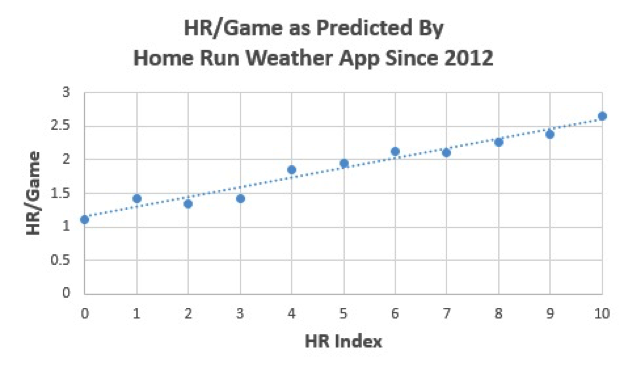BONUS: My Weather-Based Model to Predict Home Runs
As mentioned, I created a Batter HR Predictor that weights four valuable factors in projecting home runs. I’ve back-tested the importance of each input to create a model I believe will get you 90 percent of the way there when it comes to projecting home runs. Weather is of massive importance in this model, and really the area in which I think this projection system will add value over the field.
You can download the Batter HR Predictor right here. Here’s a video tutorial I created describing the methodology behind the predictor, as well as how to use it.
Some other answers to questions you might have…
How do I use this thing?
The only cells you’ll change are those located in Row 2. Most of those are ratings, with a key located on the right side of the page…pretty easy to use. You’ll need to do a bit of research to gather some of those numbers. Once you’ve changed each of the cells, the spreadsheet will auto-calculate a weighted rating and the projection (neither of which you should change).
How accurate is it?
Are these flawless projections? Not even close. Will they help you win daily fantasy baseball leagues? I think so.
It’s important to keep in mind that baseball is really, really difficult to predict. It’s not like I’m ever going to project a batter to hit three home runs, but those days happen. The goal is to increase the probability of being right so that we can get as much exposure to +EV plays as possible.
Do I need to make adjustments?
Sometimes, yes. As an example, you’ll need to adjust the inputs if the player in question moves up or down in the lineup from his normal spot. The tool will get you most of the way there, but be sure to think about ways the numbers might be off based on factors the predictors wouldn’t know about (such as injuries, lineup changes, and so on).
Will this work in the beginning of the season?
Yes, but you need to consider past stats and changes to lineups. This is a tool to put you in the right direction, but adjustments need to be made.
I typically use a rolling 12-month average to come up with the numbers early in the year, then begin to weigh the current season more heavily once we have more data a couple months into the year.
What’s the Home Run Weather app?
The Home Run Weather app is an awesome tool I use to help me quickly quantify the effect of weather on a game, specifically the probability of a team hitting a home run. Developed by statisticians and meteorologists, the app considers a number of variables and gives you a single rating—from 0 to 10—representing the likelihood of a home run occurring in a particular game.
And remember, the app has been very useful in the past.

You can download the app for iOS or Android.
Why is the ballpark weighted so lightly?
The ballpark isn’t a major factor in this model because I’m already accounting for the weather in a major way—including the temperature, air density, and wind speed—which is what I’ve found is the biggest factor when determining a park’s hitter-friendliness.
At Coors Field, for example, the majority of the park’s hitter-friendliness is due to air density, which will be captured by the Home Run Weather App.
What is SIERA?
SIERA is an adjusted ERA that has proven to be the most accurate judge of pitcher talent. You can read more about SIERA at FanGraphs, and you can use their stat finder to find just about every stat needed to use the predictors.
Thank you for enrolling in The Hidden Edge: How to Use Weather to Create a Serious Edge in Daily Fantasy Baseball. Good luck this season!
